Towards a New Digital Era: Observing Local E-Government Services Adoption in a Chinese Municipality
Abstract
:1. Introduction
2. Literature Review
2.1. E-Government Applications: From Website Portals to Multiple Channels
2.2. The Determinants of Adoption: Awareness, Intention to Use, Satisfaction and Demographic Impacts
3. E-Government in China
3.1. Local-Dominated E-Government Services
3.2. Local E-Government Services Via SNS
“WeChat is an example of, for lack of a better word, a super-app. It’s a Swiss Army life that basically does everything for you, it’s your WhatsApp, Facebook, Skype, Uber, Amazon, Instagram, Venmo and Tinder. But it’s other things we don’t even have apps for. There are hospitals that have built out whole appointment booking systems, investment services, there are even heat maps that show how crowded a place is, be it your favorite shopping mall or a popular tourist site. The list of services goes on basically forever. But it’s not the variety of things you can do on WeChat that makes it so powerful, it’s the fact that they’re all in one app…”[44]
4. Methodology
4.1. Sample and Collection
4.2. Indicators
4.3. Descriptive Statistics
4.4. Regression Analysis
5. Discussions
5.1. Digital Divide Regression Analysis
5.2. Awareness, Intention to Use and Satisfaction in Government SNS Applications
6. Conclusions
Acknowledgments
Conflicts of Interest
References
- Ronaghan, S.A. Benchmarking e-government: A global perspective. In Assessing the Progress of the UN Member States; United Nations Division for Public Economics and Public Administration & American Society for Public Administration: Ottawa, ON, Canada, 2002. [Google Scholar]
- OECD. E-Government for Better Government; OECD e-Government Studies: Paris, France, 16 November 2005. [Google Scholar]
- UN. United Nations E-Government Survey 2016; Department of Economic and Social Affairs, UN, 2016. Available online: https://publicadministration.un.org/egovkb/en-us/reports/un-e-government-survey-2016 (accessed on 20 September 2017).
- Davis, F.D. Perceived usefulness, perceived ease of use, and user acceptance of information technology. MIS Q. 1989, 13, 319–340. [Google Scholar] [CrossRef]
- Venkatesh, V.; Morris, M.G.; Davis, G.B.; Davis, F.D. User acceptance of information technology: Toward a unified view. MIS Q. 2003, 27, 425–478. [Google Scholar]
- Dunleavy, P.; Margetts, H.Z. The second wave of digital era governance. In Proceedings of the American Political Science Association Conference, Washington, DC, USA, 4 September 2010. [Google Scholar]
- Kushchu, I.; Kuscu, H. From e-government to m-government: Facing the inevitable. In Proceedings of the 3rd European Conference on E-Government, Dublin, Ireland, 3–4 July 2003; MCIL Trinity College Dublin Ireland: Dublin, Ireland, 2003; pp. 253–260. [Google Scholar]
- Trimi, S.; Sheng, H. Emerging trends in m-government. Commun. ACM 2008, 51, 53–58. [Google Scholar] [CrossRef]
- Oliveira, G.H.M.; Welch, E.W. Social media use in local government: Linkage of technology, task, and organizational context. Gov. Inf. Q. 2013, 30, 397–405. [Google Scholar] [CrossRef]
- Dunleavy, P.; Margetts, H.; Bastow, S.; Tinkler, J. New public management is dead—Long live digital-era governance. J. Public Adm. Res. Theory 2006, 16, 467–494. [Google Scholar] [CrossRef]
- Margetts, H.; Dunleavy, P. The second wave of digital-era governance: A quasi-paradigm for government on the web. Philos. Trans. R. Soc. A 2013, 371, 20120382. [Google Scholar] [CrossRef] [PubMed]
- Dunleavy, P. Gauging the Time Lags in Whitehall’s Responses to Modern Digital Processes Suggests an Enduring Problem with Organizational Culture in the Civil Service. British Politics Policy LSE. 2012. Available online: http://blogs.lse.ac.uk/politicsandpolicy/whitehall-digital-processes-timelag/ (accessed on 20 September 2017).
- Bonsón, E.; Torres, L.; Royo, S.; Flores, F. Local e-government 2.0: Social media and corporate transparency in municipalities. Gov. Inf. Q. 2012, 29, 123–132. [Google Scholar] [CrossRef]
- Magro, M.J. A review of social media use in e-government. Adm. Sci. 2012, 2, 148–161. [Google Scholar] [CrossRef]
- Dadashzadeh, M. Social media in government: From egovernment to egovernance. J. Bus. Econ. Res. 2010, 8, 81. [Google Scholar] [CrossRef]
- Hrdinová, J.; Helbig, N.; Peters, C.S. Designing Social Media Policy for Government: Eight Essential Elements; Center for Technology in Government, University at Albany: Albany, NY, USA, 2010. [Google Scholar]
- Yates, D.; Paquette, S. Emergency knowledge management and social media technologies: A case study of the 2010 haitian earthquake. Int. J. Inf. Manag. 2011, 31, 6–13. [Google Scholar] [CrossRef]
- Hellman, R. The cloverleaves of social media challenges for e-governments. In Proceedings of the eChallenges e-2011 Conference, Florence, Italy, 26–28 October 2011; pp. 1–8. [Google Scholar]
- Charbaji, A.; Mikdashi, T. A path analytic study of the attitude toward e-government in lebanon. Corp. Gov. 2003, 3, 76–82. [Google Scholar] [CrossRef]
- Gunter, B.; Mellor, N. E-Citizen: Developing Research-Based Marketing Communications to Increase Awareness and Take-Up of Local Authority E-Channels; Aslib proceedings, Emerald Group Publishing Limited: West Yorkshire, UK, 2006; pp. 436–446. [Google Scholar]
- Ward, B.; Connolly, R.; Hackney, R. E-Government Awareness among the Techno-Disadvantaged in the United States. 2011. Available online: http://bura.bura.brunel.ac.uk/handle/2438/8478 (accessed on 20 September 2017).
- Chan, F.K.; Thong, J.Y.; Venkatesh, V.; Brown, S.A.; Hu, P.J.; Tam, K.Y. Modeling citizen satisfaction with mandatory adoption of an e-government technology. J. Assoc. Inf. Syst. 2011, 11, 519–549. [Google Scholar]
- Sia, C.-L.; Lee, M.K.; Teo, H.-H.; Wei, K.-K. Information instruments for creating awareness in it innovations: An exploratory study of organizational adoption intentions of valunet. Electron. Mark. 2001, 11, 206–215. [Google Scholar] [CrossRef]
- Sipior, J.C.; Ward, B.T.; Connolly, R. The digital divide and t-government in the united states: Using the technology acceptance model to understand usage. Eur. J. Inf. Syst. 2011, 20, 308–328. [Google Scholar] [CrossRef]
- Aerschot, L.V.; Rodousakis, N. The link between socio-economic background and internet use: Barriers faced by low socio-economic status groups and possible solutions. Innovation 2008, 21, 317–351. [Google Scholar] [CrossRef]
- Anna Xiong, J. Current status and needs of chinese e-government users. Electron. Libr. 2006, 24, 747–762. [Google Scholar] [CrossRef]
- Islam, M.S.; Scupola, A. E-service research trends in the domain of e-government: A contemporary study. Int. J. E-Serv. Mob. Appl. 2011, 3. [Google Scholar] [CrossRef] [Green Version]
- Venkatesh, V.; Davis, F.D. A theoretical extension of the technology acceptance model: Four longitudinal field studies. Manag. Sci. 2000, 46, 186–204. [Google Scholar] [CrossRef]
- Choudrie, J.; Dwivedi, Y. A Survey of Citizens Adoption and Awareness of E-Government Initiatives, the Government Gateway: A United Kingdom Perspective; E-Government Workshop; Brunel University: London, UK, 2005. [Google Scholar]
- Curtis, L.; Edwards, C.; Fraser, K.L.; Gudelsky, S.; Holmquist, J.; Thornton, K.; Sweetser, K.D. Adoption of social media for public relations by nonprofit organizations. Public Relat. Rev. 2010, 36, 90–92. [Google Scholar] [CrossRef]
- Alawneh, A.; Al-Refai, H.; Batiha, K. Measuring user satisfaction from e-government services: Lessons from jordan. Gov. Inf. Q. 2013, 30, 277–288. [Google Scholar] [CrossRef]
- Stiftung, B. Balanced E-Government: E-Government–Connecting Efficient Administration and Responsive Democracy; Bertelsmann Stiftung: Gütersloh, Germany, 2002. [Google Scholar]
- Kumar, V.; Mukerji, B.; Butt, I.; Persaud, A. Factors for successful e-government adoption: A conceptual framework. Electron. J. E-Gov. 2007, 5, 63–76. [Google Scholar]
- Colesca, S.; Dobrica, L. Adoption and use of e-government services: The case of romania. J. Appl. Res. Technol. 2008, 6, 204–217. [Google Scholar]
- Verdegem, P.; Verleye, G. User-centered e-government in practice: A comprehensive model for measuring user satisfaction. Gov. Inf. Q. 2009, 26, 487–497. [Google Scholar] [CrossRef]
- Welch, E.W.; Hinnant, C.C.; Moon, M.J. Linking citizen satisfaction with e-government and trust in government. J. Public Adm. Res. Theory 2004, 15, 371–391. [Google Scholar] [CrossRef]
- Morgeson, F.V.; Petrescu, C. Do they all perform alike? An examination of perceived performance, citizen satisfaction and trust with us federal agencies. Int. Rev. Adm. Sci. 2011, 77, 451–479. [Google Scholar] [CrossRef]
- Morgeson, F.V., III; VanAmburg, D.; Mithas, S. Misplaced trust? Exploring the structure of the e-government-citizen trust relationship. J. Public Adm. Res. Theory 2010, 21, 257–283. [Google Scholar] [CrossRef]
- Tan, M. An investigation of e-government services in china. Electron. J. Inf. Syst. Dev. Ctries. 2013, 57, 1–20. [Google Scholar]
- Newell, G.; Wing Chau, K.; Kei Wong, S. The significance and performance of infrastructure in china. J. Prop. Invest. Financ. 2009, 27, 180–202. [Google Scholar] [CrossRef]
- Economist, T. Wechat’s World: China’s Wechat Shows the Way to Social Media’s Future. 2016. Available online: https://www.economist.com/news/business/21703428-chinas-wechat-shows-way-social-medias-future-wechats-world (accessed on 20 September 2017).
- QuestMobile. Top 2000 Apps in China: Autumn 2016 Review. Available online: http://www.questmobile.com.cn/blog/en/blog_63.html (accessed on 20 September 2017).
- Schlæger, J.; Jiang, M. Official microblogging and social management by local governments in china. Chin. Inf. 2014, 28, 189–213. [Google Scholar] [CrossRef]
- Jonah, M.; Kessel, P.M. How China Is Changing Your Internet. Asia Pacific NewYork Times. 2016. Available online: https://www.yahoo.com/news/york-times-china-changing-internet-081310832.html (accessed on 20 September 2017).
- Hou, E. Government wechat, expired “old ticket”—Disregard the changing circumstances, how far could the new deal? Chin. Media Rep. Overseas 2014, 10, 1–8. [Google Scholar]
- Harwit, E. Wechat: Social and Political Development of China’s Dominant Messaging App. Chin. J. Commun. 2016, 1–16. Available online: http://www.tandfonline.com/doi/abs/10.1080/17544750.2016.1213757?journalCode=rcjc20 (accessed on 20 September 2017).
- Dooley, K. Social Research Methods, 4th ed.; Citeseer: Upper Saddle River, NJ, USA, 2001. [Google Scholar]
- National Bureau of Statistics of China. Population and Employment; National Data, National Bureau of Statistics of China: Beijing, China, 2015.
- Portal, C.G.O. Chongqing Municipal Government. Available online: https://web.archive.org/web/20120212174208/; http://english.cq.gov.cn:80/; (accessed on 4 September 2017).
- Seawright, J.; Gerring, J. Case selection techniques in case study research: A menu of qualitative and quantitative options. Political Res. Q. 2008, 61, 294–308. [Google Scholar] [CrossRef]
- Hilbert, M. Digital Gender Divide or Technologically Empowered Women in Developing Countries? A Typical Case of Lies, Damned Lies, and Statistics; Women’s Studies International Forum, Elsevier: London, UK, 2011; pp. 479–489. [Google Scholar]
- Van Dijk, J.; Hacker, K. The digital divide as a complex and dynamic phenomenon. Inf. Soc. 2003, 19, 315–326. [Google Scholar] [CrossRef]
- Chan, K.W. The household registration system and migrant labor in china: Notes on a debate. Popul. Dev. Rev. 2010, 36, 357–364. [Google Scholar] [CrossRef] [PubMed]
- Verba, S.; Burns, N.; Schlozman, K.L. Knowing and caring about politics: Gender and political engagement. J. Politics 1997, 59, 1051–1072. [Google Scholar] [CrossRef]
- Taipale, S. The use of e-government services and the internet: The role of socio-demographic, economic and geographical predictors. Telecommun. Policy 2013, 37, 413–422. [Google Scholar] [CrossRef]
- Chatfield, A.T.; Alhujran, O. A cross-country comparative analysis of e-government service delivery among arab countries. Inf. Technol. Dev. 2009, 15, 151–170. [Google Scholar] [CrossRef]
- Zhao, F.; Collier, A.; Deng, H. A multidimensional and integrative approach to study global digital divide and e-government development. Inf. Technol. People 2014, 27, 38–62. [Google Scholar] [CrossRef]
- OECD. Understanding the Digital Divide; OECD Publishing: Paris, France, 2001; Available online: http://www.oecd-ilibrary.org/science-and-technology/understanding-the-digital-divide_236405667766 (accessed on 20 September 2017).
- Bélanger, F.; Carter, L. The impact of the digital divide on e-government use. Commun. ACM 2009, 52, 132–135. [Google Scholar] [CrossRef]
- Gauld, R.; Goldfinch, S.; Horsburgh, S. Do they want it? Do they use it? The ‘demand-side’ of e-government in australia and new zealand. Gov. Inf. Q. 2010, 27, 177–186. [Google Scholar] [CrossRef]
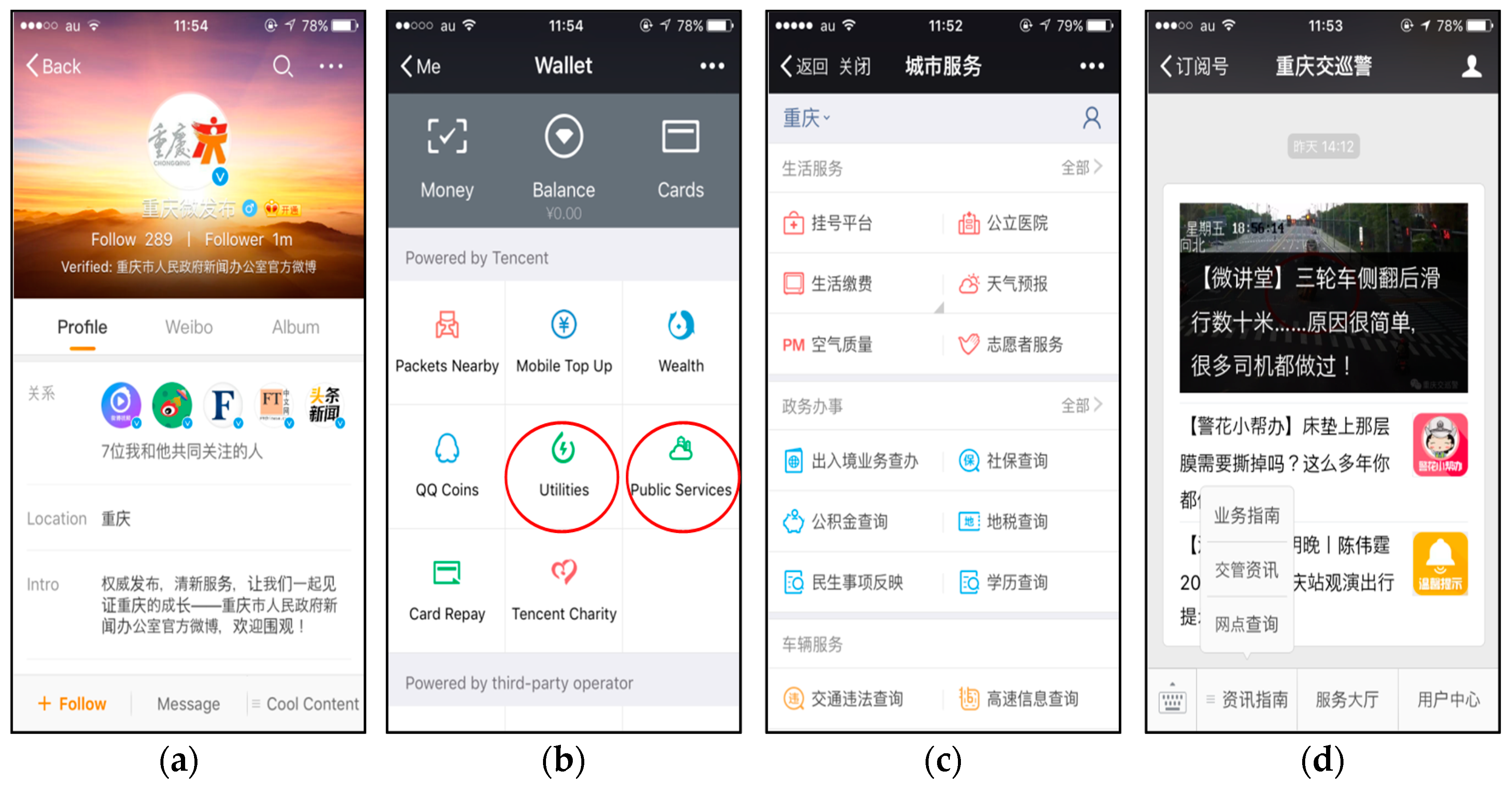

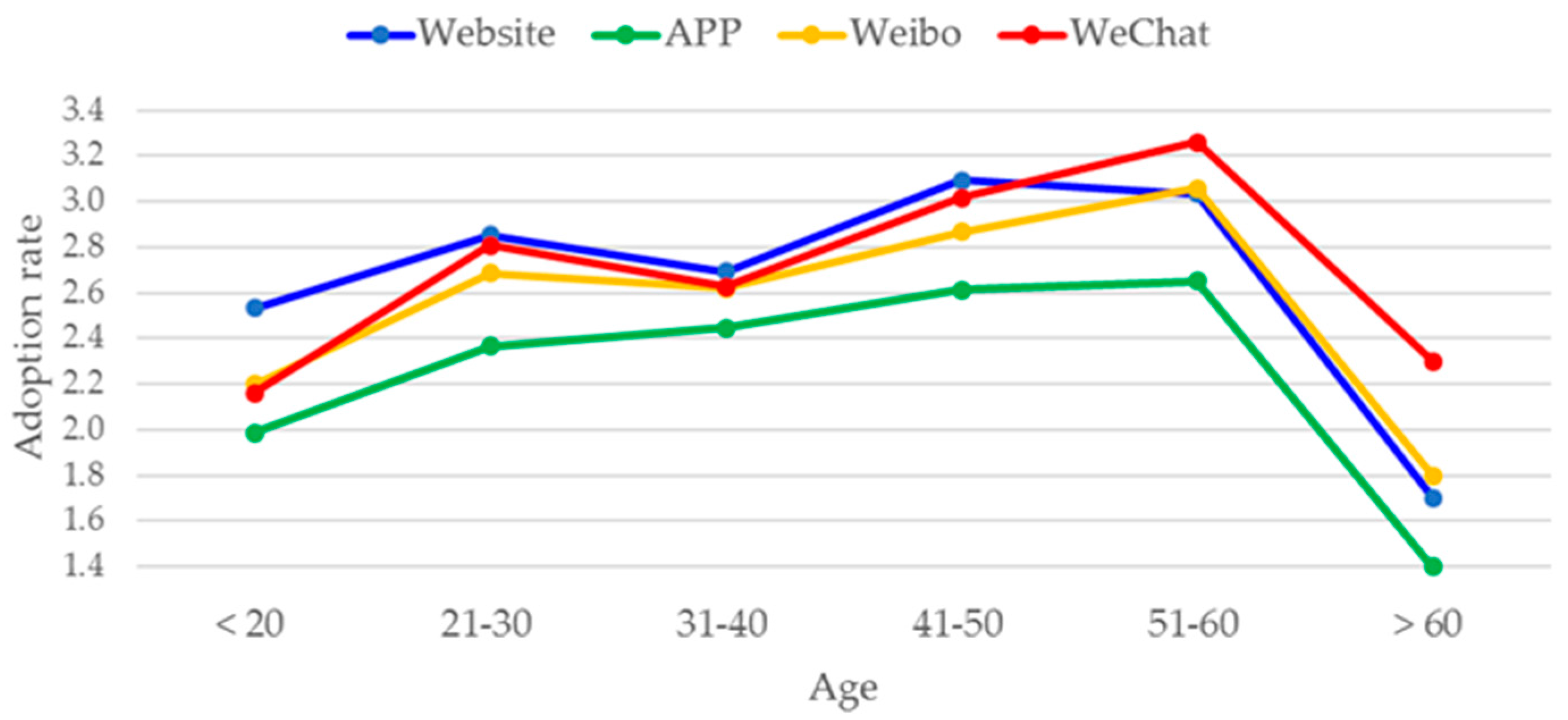
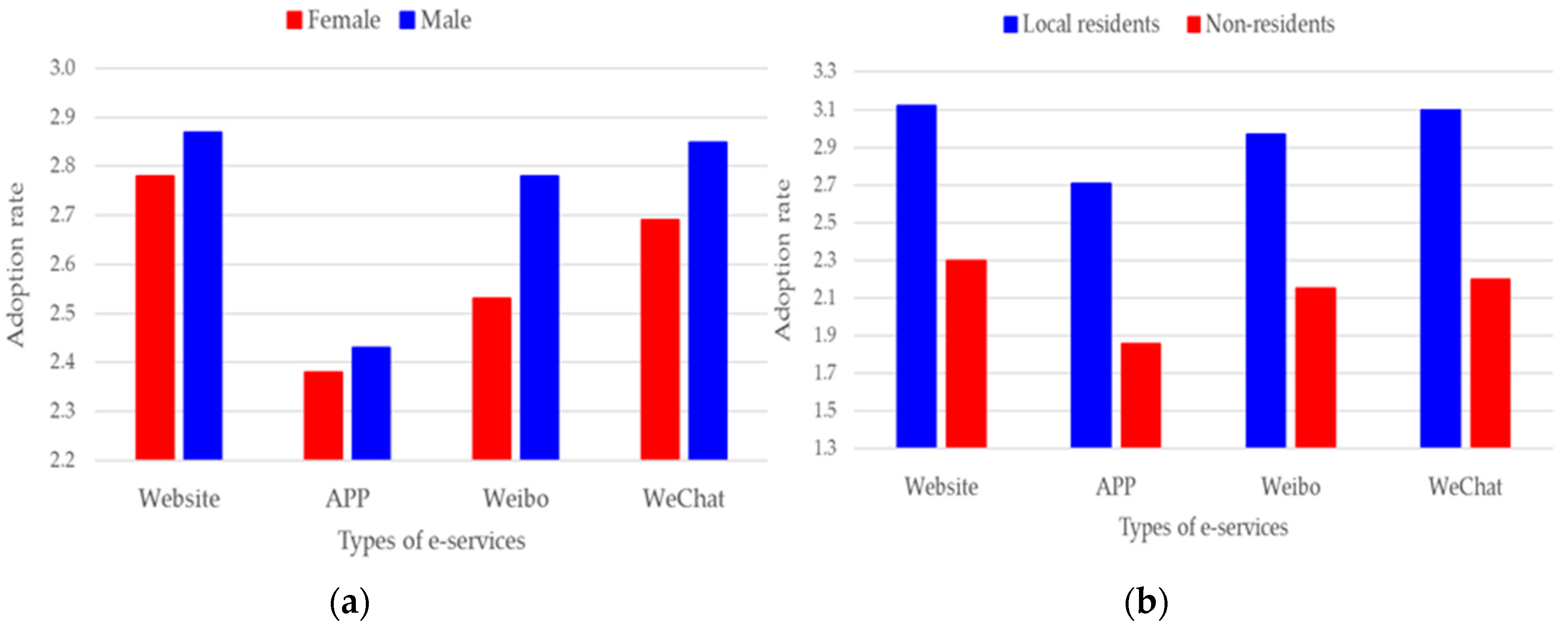
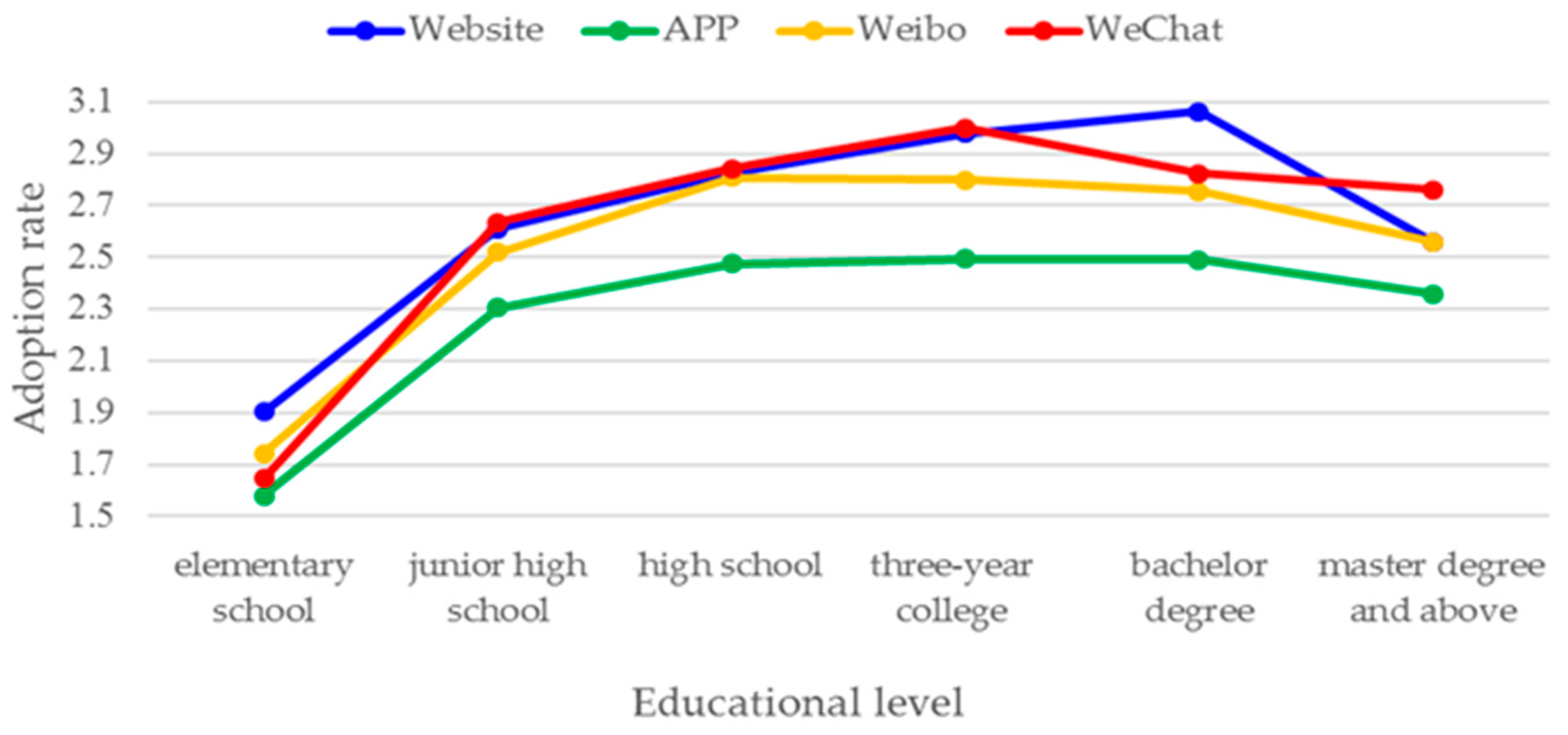
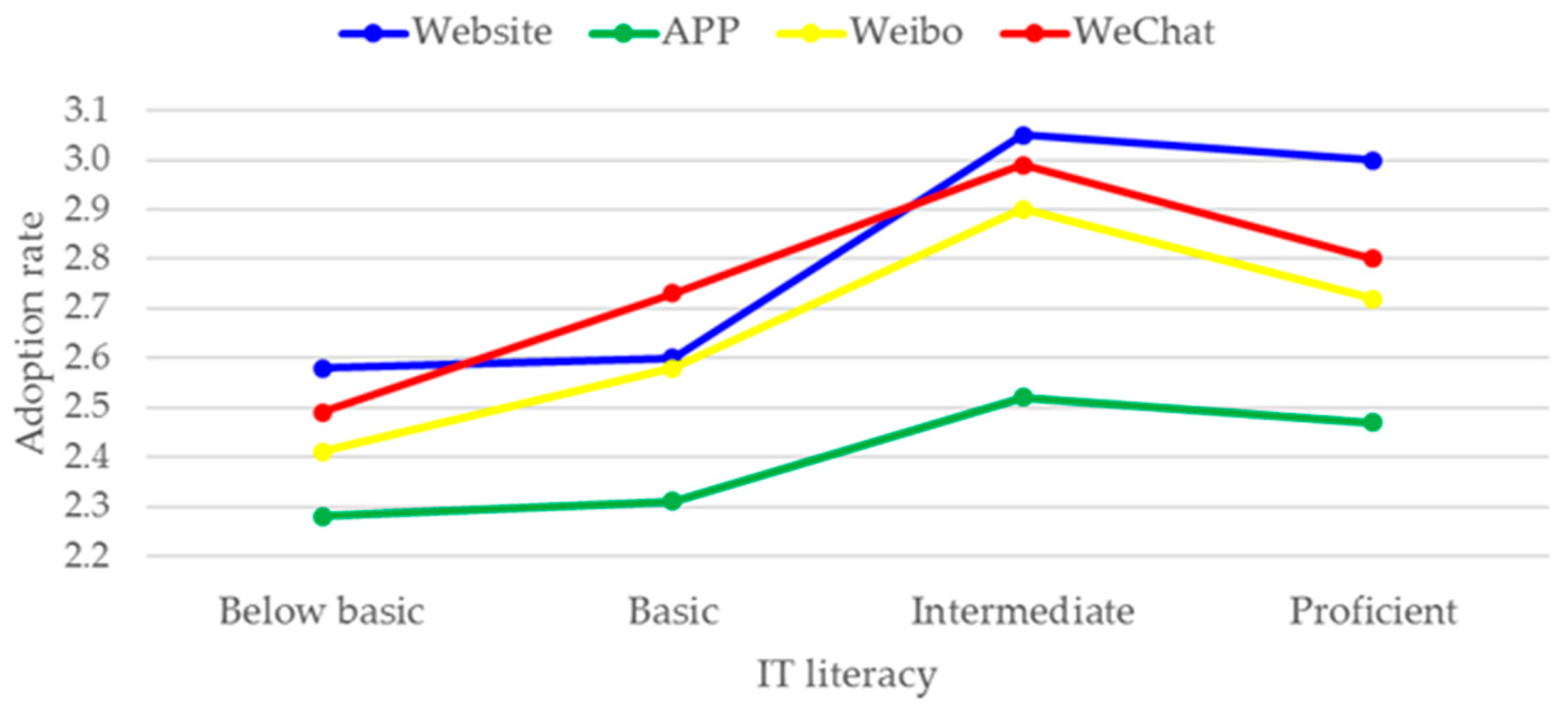
| Characteristic | No. (N = 605) | Percentage (%) |
|---|---|---|
| Age (years) | ||
| Under 20 | 75 | 12.40% |
| 21–30 | 191 | 31.57% |
| 31–40 | 121 | 20.00% |
| 41–50 | 119 | 19.67% |
| 51–60 | 89 | 14.71% |
| Over 60 | 10 | 1.65% |
| Gender | ||
| Male | 379 | 62.64% |
| Female | 226 | 37.36% |
| Chongqing residency | ||
| Resident | 394 | 65.12% |
| Non-resident | 211 | 34.88% |
| Education (Highest educational level completed) | ||
| Elementary school | 31 | 5.12% |
| Junior high school | 85 | 14.05% |
| High school | 147 | 24.30% |
| Three-year college | 174 | 28.76% |
| Bachelor degree | 143 | 23.64% |
| Master degree and above | 25 | 4.13% |
| IT literacy | ||
| Below basic | 89 | 14.71% |
| Basic | 180 | 29.75% |
| Intermediate | 180 | 29.75% |
| Proficient | 156 | 25.79% |
| Variable | WeChat Adoption | App Adoption | Weibo Adoption | WeChat Adoption | ||||||||
|---|---|---|---|---|---|---|---|---|---|---|---|---|
| Coef | SE | t | Coef | SE | t | Coef | SE | t | Coef | SE | t | |
| Age | 0.02 | 0.03 | 0.64 | 0.03 | 0.04 | 0.96 | 0.06 | 0.03 | 1.96 * | 0.10 | 0.03 | 3.32 *** |
| Gender (ref = female) | 0.04 | 0.08 | 0.45 | 0.02 | 0.09 | 0.25 | 0.16 | 0.08 | 1.98 * | 0.12 | 0.08 | 1.51 |
| Local Residency (ref = non) | 0.27 | 0.08 | 3.10 ** | 0.39 | 0.99 | 3.99 *** | 0.15 | 0.09 | 1.99 * | 0.26 | 0.09 | 3.04 ** |
| Education | 0.01 | 0.04 | 0.24 | −0.06 | 0.04 | −1.41 | 0.00 | 0.04 | 0.02 | 0.06 | 0.04 | 1.54 |
| IT literacy | 0.01 | 0.05 | 0.04 | −0.02 | 0.05 | −0.35 | −0.02 | 0.04 | −0.51 | −0.05 | 0.04 | −0.11 |
| Awareness | ||||||||||||
| Web | 0.63 | 0.04 | 15.58 *** | |||||||||
| App | 0.34 | 0.04 | 8.68 *** | |||||||||
| 0.70 | 0.04 | 17.94 *** | ||||||||||
| 0.55 | 0.04 | 14.61 *** | ||||||||||
| Intention to Use | ||||||||||||
| Web | 0.12 | 0.04 | 2.77 ** | |||||||||
| App | 0.18 | 0.05 | 3.56 *** | |||||||||
| 0.10 | 0.04 | 2.29 * | ||||||||||
| 0.09 | 0.04 | 2.11 * | ||||||||||
| Satisfaction | ||||||||||||
| Web | 0.12 | 0.05 | 2.61 ** | |||||||||
| App | 0.37 | 0.05 | 6.99 *** | |||||||||
| 0.19 | 0.05 | 3.97 *** | ||||||||||
| 0.18 | 0.05 | 3.76 *** | ||||||||||
| Constant | 0.023 | 0.26 | −0.52 | 0.26 | −0.54 | 0.23 | −0.30 | 0.23 | ||||
| Observations | 605 | 605 | 605 | 605 | ||||||||
| R-squared | 0.50 | 0.38 | 0.55 | 0.50 | ||||||||
| Variable | Website Adoption | App Adoption | Weibo Adoption | WeChat Adoption | ||||
|---|---|---|---|---|---|---|---|---|
| VIF | 1/VIF | VIF | 1/VIF | VIF | 1/VIF | VIF | 1/VIF | |
| Age | 1.15 | 0.87 | 1.18 | 0.85 | 1.15 | 0.87 | 1.17 | 0.85 |
| Gender (ref = female) | 1.02 | 0.98 | 1.02 | 0.98 | 1.03 | 0.97 | 1.03 | 0.97 |
| Residency (ref = non) | 1.13 | 0.89 | 1.14 | 0.88 | 1.16 | 0.86 | 1.18 | 0.85 |
| Education | 1.44 | 0.69 | 1.46 | 0.68 | 1.44 | 0.69 | 1.45 | 0.69 |
| IT literacy | 1.57 | 0.64 | 1.57 | 0.64 | 1.57 | 0.64 | 1.58 | 0.63 |
| Awareness | ||||||||
| Web | 1.54 | 0.65 | ||||||
| App | 1.32 | 0.76 | ||||||
| 1.54 | 0.65 | |||||||
| 1.59 | 0.63 | |||||||
| Intention to Use | ||||||||
| Web | 1.51 | 0.66 | ||||||
| App | 1.50 | 0.67 | ||||||
| 1.43 | 0.70 | |||||||
| 1.43 | 0.70 | |||||||
| Satisfaction | ||||||||
| Web | 1.43 | 0.70 | ||||||
| App | 1.47 | 0.68 | ||||||
| 1.48 | 0.68 | |||||||
| 1.51 | 0.66 | |||||||
| Mean VIF | 1.35 | 1.33 | 1.35 | 1.37 | ||||
© 2017 by the author. Licensee MDPI, Basel, Switzerland. This article is an open access article distributed under the terms and conditions of the Creative Commons Attribution (CC BY) license (http://creativecommons.org/licenses/by/4.0/).
Share and Cite
Yang, Y. Towards a New Digital Era: Observing Local E-Government Services Adoption in a Chinese Municipality. Future Internet 2017, 9, 53. https://doi.org/10.3390/fi9030053
Yang Y. Towards a New Digital Era: Observing Local E-Government Services Adoption in a Chinese Municipality. Future Internet. 2017; 9(3):53. https://doi.org/10.3390/fi9030053
Chicago/Turabian StyleYang, Yao. 2017. "Towards a New Digital Era: Observing Local E-Government Services Adoption in a Chinese Municipality" Future Internet 9, no. 3: 53. https://doi.org/10.3390/fi9030053





